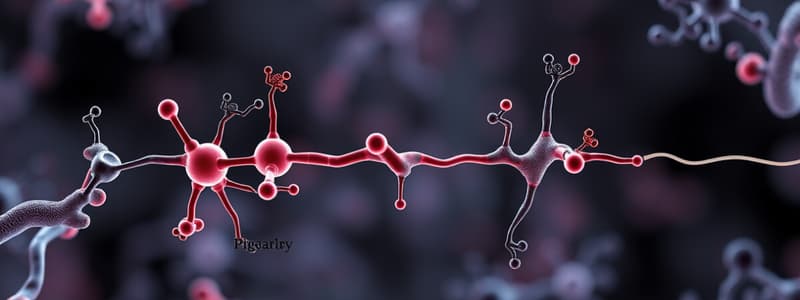Podcast
Questions and Answers
What is the primary mechanism through which intrinsic enzyme receptors activate a signal transduction cascade?
What is the primary mechanism through which intrinsic enzyme receptors activate a signal transduction cascade?
Phosphorylation through dimerization and autophosphorylation.
Identify the first step in the activation of intrinsic enzyme receptors.
Identify the first step in the activation of intrinsic enzyme receptors.
Ligand binding.
What structural feature characterizes DNA binding receptors, facilitating their role in gene activation?
What structural feature characterizes DNA binding receptors, facilitating their role in gene activation?
Zinc fingers.
Name two types of hormones that DNA binding receptors are activated by.
Name two types of hormones that DNA binding receptors are activated by.
Describe the relationship between dimerization and the functionality of intrinsic enzyme receptors.
Describe the relationship between dimerization and the functionality of intrinsic enzyme receptors.
What is the final step in the activation process of intrinsic enzyme receptors after autophosphorylation?
What is the final step in the activation process of intrinsic enzyme receptors after autophosphorylation?
To what cellular location do DNA binding receptors translocate after activation in the cytosol?
To what cellular location do DNA binding receptors translocate after activation in the cytosol?
List one function of intrinsic enzyme receptors in cellular signaling.
List one function of intrinsic enzyme receptors in cellular signaling.
Which family of receptors has the largest number of types?
Which family of receptors has the largest number of types?
Define an orphan receptor.
Define an orphan receptor.
What is the next step in the activation of Intrinsic Enzyme Receptors after ligand binding?
What is the next step in the activation of Intrinsic Enzyme Receptors after ligand binding?
What is a key requirement for the ligands of DNA Binding Receptors?
What is a key requirement for the ligands of DNA Binding Receptors?
Compare the amplification levels of ion channel receptors and intrinsic enzyme receptors.
Compare the amplification levels of ion channel receptors and intrinsic enzyme receptors.
Why do steroid hormones require dimerization of receptors in the cytosol?
Why do steroid hormones require dimerization of receptors in the cytosol?
What distinguishes the speed of response between ion channel receptors and DNA binding receptors?
What distinguishes the speed of response between ion channel receptors and DNA binding receptors?
Explain the significance of the zinc finger domain in receptor function.
Explain the significance of the zinc finger domain in receptor function.
Why has the classification of receptors by ligands become inadequate?
Why has the classification of receptors by ligands become inadequate?
What are the four families of receptors identified in the context?
What are the four families of receptors identified in the context?
What are the three subfamilies of ion channel receptors?
What are the three subfamilies of ion channel receptors?
What structural commonality is shared by all ion channel receptors?
What structural commonality is shared by all ion channel receptors?
What characterizes G-protein coupled receptors (GPCRs) in terms of their membrane structure?
What characterizes G-protein coupled receptors (GPCRs) in terms of their membrane structure?
How many genes in the human genome are estimated to code for GPCRs?
How many genes in the human genome are estimated to code for GPCRs?
What distinguishes Class A GPCRs from Class B GPCRs regarding their ligand binding site?
What distinguishes Class A GPCRs from Class B GPCRs regarding their ligand binding site?
In Class C GPCRs, where is the ligand binding site located?
In Class C GPCRs, where is the ligand binding site located?
What are the endogenous ligands for Thyroid Hormone Receptors and Liver X Receptors?
What are the endogenous ligands for Thyroid Hormone Receptors and Liver X Receptors?
Identify the endogenous ligands associated with Glucocorticoid Receptors.
Identify the endogenous ligands associated with Glucocorticoid Receptors.
List all members of subgroup III and their corresponding ligands.
List all members of subgroup III and their corresponding ligands.
What ligands do members of subgroup IV bind to?
What ligands do members of subgroup IV bind to?
What function does dimerization serve in the DNA binding receptor activation process?
What function does dimerization serve in the DNA binding receptor activation process?
Which subgroup includes the Chicken Ovalbumin Upstream Promoter Transcription Factors and what type of ligands do they correspond to?
Which subgroup includes the Chicken Ovalbumin Upstream Promoter Transcription Factors and what type of ligands do they correspond to?
What is unique about the Germ Cell Nuclear Factor in terms of endogenous ligands?
What is unique about the Germ Cell Nuclear Factor in terms of endogenous ligands?
Explain the role of translocation in the activation of DNA binding receptors.
Explain the role of translocation in the activation of DNA binding receptors.
How are ion channel receptors commonly classified based on their structure?
How are ion channel receptors commonly classified based on their structure?
What types of ions do cationic ion channels typically allow to pass through?
What types of ions do cationic ion channels typically allow to pass through?
What distinguishes G-protein coupled receptor subfamilies from each other?
What distinguishes G-protein coupled receptor subfamilies from each other?
Why are intrinsic enzyme receptors significant in pharmacology?
Why are intrinsic enzyme receptors significant in pharmacology?
What role do DNA binding receptors play in cellular function?
What role do DNA binding receptors play in cellular function?
Describe how pentameric ion channels differ from tetrameric ion channels in structure.
Describe how pentameric ion channels differ from tetrameric ion channels in structure.
What is the significance of the ligand binding site in ion channel receptors?
What is the significance of the ligand binding site in ion channel receptors?
How do receptor operated ion channels facilitate neuronal signaling?
How do receptor operated ion channels facilitate neuronal signaling?
What defines the excitatory nature of certain ion channels in neurotransmission?
What defines the excitatory nature of certain ion channels in neurotransmission?
In what way do subunit compositions in homopentameric vs heteropentameric channels affect their function?
In what way do subunit compositions in homopentameric vs heteropentameric channels affect their function?
Flashcards are hidden until you start studying
Study Notes
Learning Outcomes
- Classification of receptors by structure and function.
- Recognition of subfamilies within receptor families.
- Description of receptor structures in four main families.
- Understanding functions of receptors across the four families.
Overview of Receptor Classification
- Receptors can be categorized by:
- Function: Opening ion channels, activating G-proteins, triggering enzymes, interacting with DNA.
- Structure: Understanding protein composition and amino acid/nucleotide sequences.
Receptor Families
- Major families include:
- Ion channel receptors
- G-protein coupled receptors (GPCRs)
- Intrinsic enzyme receptors
- DNA binding receptors
Ion Channel Receptors
- Also known as ionotropic, ligand-gated, or receptor-operated ion channels.
- Types include:
- Pentameric (e.g., GABAA, Nicotinic acetylcholine, 5-HT3)
- Tetrameric (e.g., NMDA, AMPA, Kainate receptors)
- Trimeric (e.g., P2X receptors)
Pentameric Ion Channels
-
Pentameric ion channels are complexes formed by five subunits. These can either be homopentamers, which consist of identical subunits, or heteropentamers, composed of different types of subunits. This structural diversity allows for varying functional properties and regulatory mechanisms.
-
Ligand binding for pentameric channels occurs in the extracellular space, which is crucial for channel activation. The binding of specific ligands triggers conformational changes that lead to ion flow through the channel.
-
These channels allow the passage of several common ions: sodium ions (Na⁺) and calcium ions (Ca²⁺) contribute to depolarization of the membrane, while potassium ions (K⁺) and chloride ions (Cl⁻) primarily cause hyperpolarization, which is essential for returning the membrane potential to a resting state.
Tetrameric Ion Channels
-
Tetrameric ion channels are made up of four subunits, which are always heteropentamers, meaning they are composed of different subunit types. This arrangement is critical for their functioning and specificity to certain ions.
-
These channels consist of three transmembrane domains that encircle a central flexible pore. The design of the pore adapts according to ion type, ensuring proper ion selectivity and conductance.
-
They are permeable to common ions such as sodium (Na⁺), potassium (K⁺), and sometimes calcium (Ca²⁺), contributing to various physiological processes, including muscle contraction and neurotransmission.
Trimeric Ion Channels
-
Trimeric ion channels are organized into three subunits, and their structure prominently features two alpha helices, which play a crucial role in the stability and functionality of the channel.
-
The architecture of these channels is primarily extracellular, which facilitates the process of depolarization as ions flow through the channel upon activation, playing key roles in signal transduction across neuronal and muscle membranes.
G-Protein Coupled Receptors (GPCRs)
- Also referred to as metabotropic, seven membrane-spanning, or serpentine receptors.
- Made up of approximately 1200 genes (3-4% of the human genome), with 67% being odorant receptors.
- Classes include:
- Class A: Ligand binding site is in the transmembrane domain.
- Class B: Ligand binding occurs externally, suited for large proteins.
- Class C: Bind ligands in the extracellular domain and typically act as dimers.
Intrinsic Enzyme Receptors
- Known as pleiotropic or catalytic receptors.
- Include receptors for growth factors, cytokines, and insulin.
- Function via phosphorylation:
- Steps: Ligand binding, dimerization, autophosphorylation, substrate phosphorylation.
DNA Binding Receptors
- Referenced as nuclear receptors or ligand-activated transcription factors, utilizing zinc fingers.
- Bind to steroid hormones, thyroid hormones, and retinoic acid.
- Activated in the cytosol and migrate to the nucleus to affect transcription.
Properties of Different Receptor Families
- Ion Channels: Multiple subunits, very fast response (µs-ms), low amplification.
- GPCRs: Single protein, fast response (ms-s), very high amplification.
- Intrinsic Enzymes: Often dimers, slow response (mins-hours), high amplification.
- DNA Binding: Dimers, very slow response (hours-days), high amplification.
Key Concepts and Terminology
- Orphan receptor: A receptor with a known structure but no identified ligand.
- Ligands for DNA binding receptors must be lipophilic to cross the plasma membrane.
- Receptor types and their mechanisms enable diverse physiological responses and signal amplification.
Studying That Suits You
Use AI to generate personalized quizzes and flashcards to suit your learning preferences.




